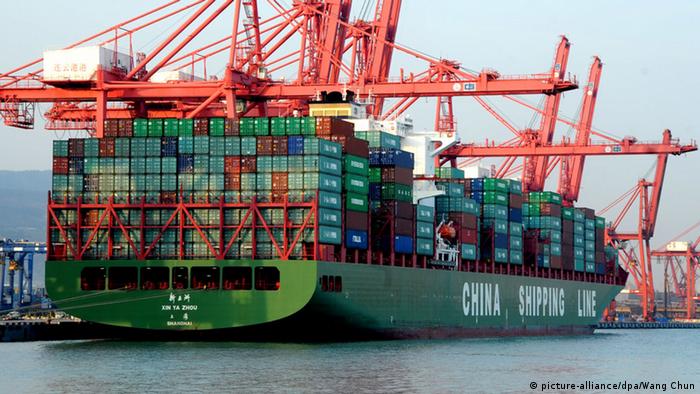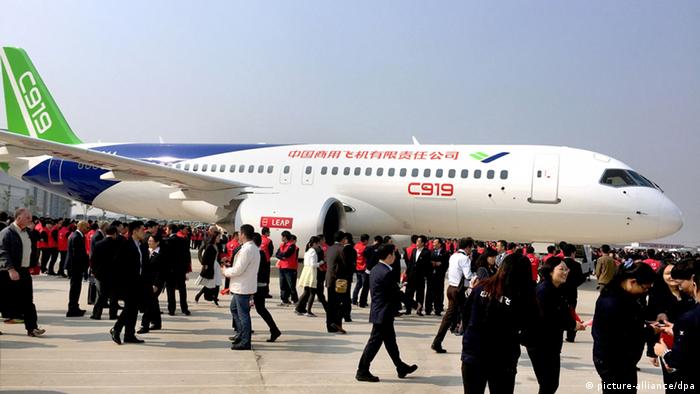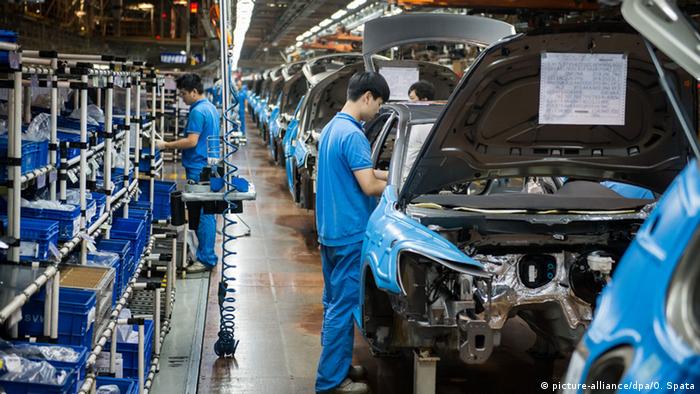Summary
Europe and China have been two of the main targets in the United States’ recent efforts to cut its trade deficit. At the start of this month, the Trump administration slapped tariffs on aluminum and steel from European Union members (along with other countries), after initially exempting the bloc from the tariffs. The EU has said it will impose its own set of tariffs on the U.S. in July. Germany, Europe’s economic powerhouse, has been particularly vocal in its opposition to the American tariffs. Its economy is heavily dependent on exports, which accounted for 46 percent of Germany’s gross domestic product in 2016. Though Germany’s main export destination is the European Union (58 percent of goods exports in 2016), its second-largest customer is the United States (8.8 percent), followed by China (6.4 percent).
China, meanwhile, has been engaged in a trade dispute of its own with the U.S. essentially since President Donald Trump took office. Most recently, the Trump administration imposed tariffs on $50 billion worth of Chinese imports last week, and China responded by promising to do the same. Trump also threatened to impose tariffs on an additional $200 billion worth of Chinese goods this week, further escalating the trade row. Given that exports made up 19.6 percent of China’s GDP in 2016, any disruption in trade flows will be a big concern for the Chinese.
China and Germany now find themselves in a peculiar position. Neither is in a position to engage in a trade war, yet both are increasingly at odds with the world’s largest economy. Given this scenario, they may look for alternatives to the U.S., and as the world’s second- and fourth-largest economies, they may see each other as options. In light of the intensifying trade dispute with the U.S., this Deep Dive will explore the possibility of greater economic cooperation between China and Germany.
The Opportunities
One thing the Chinese and Germans have in common is that both have benefited from the relaxation of trade restrictions. Since the gradual opening of China’s economy under Deng Xiaoping, the abundance of cheap labor in China has attracted investment from around the globe. Cheap Chinese-made products have flooded markets around the world, including the U.S., which consumed 19 percent of Chinese exports in 2017. Germany, meanwhile, has profited massively from the European common market and the common currency. Under the euro, German exports are cheaper and more competitive than they were under the deutsche mark.
Trade between the two export-dominated economies is growing: China became Germany’s top trade partner in 2016, when trade between the two countries reached 170.2 billion euros ($197 billion). It grew to 186.6 billion euros the following year. Beijing has a trade surplus with Berlin, even though only 3.1 percent of Chinese exports (worth $71.2 billion) were destined for Germany in 2017.
For China, there are some notable benefits to trade with Germany. In Germany, the Chinese can access complex technologies that are not yet produced in China. In 2017, the Chinese invested $13.7 billion in German companies, making the country China’s top destination for investment in Europe. As part of the Made in China 2025 strategy, a plan announced in 2015 to modernize Chinese industry, China is trying to increase development of high-tech sectors in the country, and for this, it needs access to technologies from foreign firms. Investing in German companies may prove useful in this regard. Foreign investment in Germany isn’t tightly regulated (for now, at least), making it easier for Chinese businesses to gain a foothold there.
According to a study by the Bertelsmann Foundation, a majority of Chinese investments in Germany are made in sectors that are the focus of the Made in China 2025 strategy. Prior to 2015, the year the strategy was announced, there was little Chinese investment in the biomedicine and biomedical devices sector, for example. Since then, there have been 18 such partnerships between Chinese and German companies.
The Bertelsmann Foundation looked at 175 merger and acquisition transactions in which the Chinese bought at least a 10 percent share in German companies from 2014 to 2017. Nearly 64 percent of these investments were directed at sectors that China plans to dominate by 2025. Most of the investment related to Made in China 2025 is focused on three regions: Baden-Wuerttemberg (23 percent), North Rhine-Westphalia (20 percent) and Bavaria (16 percent). These are precisely the regions where most world-leading German tech firms are based.
In addition, Germany serves as a key hub for Chinese goods destined for European markets by sea and rail. One in three containers that arrive in Hamburg, Germany’s main freight port, come from China, and several rail lines used to transport cargo by train to Europe begin in China and end in Germany, including the Chongqing-Duisburg line.
There are also advantages for Germany from this relationship. China is a top destination for Germany’s high value-added exports, and there are more than 5,000 German companies operating there today. Until recently, China was the main source of cheap labor for German multinational corporations. German imports from China include products made in China for German companies and products sold by Chinese companies, including low added-value products such as textiles.
In 2016, 50 percent of EU foreign investment was destined for China. German investors are attracted to China because of low labor and R&D costs. According to a 2017 survey by the German Chamber of Commerce in China, more than half of new investment by German companies in 2018 will be in manufacturing facilities. German investment is concentrated in the city of Taicang, which is close to Shanghai, one of the busiest ports in China but a much more expensive city from which to base a business. Since August 2016, Taicang has attracted more than 250 small and medium-sized German businesses that together have revenue of roughly $2.72 billion. The Taicang German Center, a project created by a German bank and supported by federal and state ministries in Germany, helps German businesses enter the Chinese market. Many businesses operating in Taicang are related to machine construction, electronics and energy. Shanghai, Beijing, Guangzhou and Shenzhen are also popular cities for investment.
If Germany were to try to redirect its trade from the U.S. to China, it wouldn’t have to significantly adjust the composition of its exports. In 2017, China was Germany’s third-largest destination for exports (and top supplier of imports). In 2016, roughly 67 percent of Chinese imports from Germany (worth $56.1 billion) and 58 percent of U.S. imports from Germany (worth $66 billion) were part of the transportation and machinery sectors. Since German exports to both countries have a similar profile, reorienting German exports to the Chinese market wouldn’t require a massive shift in production.
The Obstacles
There is, therefore, a lot of potential in this relationship. But there are also many hurdles. From the Chinese perspective, the main challenge to seeing Germany as an alternative to the U.S. market is the sheer size of the country’s population. The United States is a wealthy country with a population of 327 million, whereas Germany has a population of only 82 million. Because of this gap, Germany can’t absorb the quantity of Chinese goods that the United States does.
From the German perspective, there are three main obstacles to increasing investment in and trade with China. The first is costly bureaucratic delays. China requires most products sold there to have a China Compulsory Certificate, which requires factory visits at the expense of the manufacturer to ensure compliance and the submission of valuable company information. The certification process is usually very lengthy, providing a window of opportunity for Chinese counterfeits to appear on the market before the original product does. This is a hurdle particularly for small and medium-sized businesses with limited resources.
There are also restrictions on foreign investment in certain industries such as automobiles, petrochemicals and steel. In many manufacturing and service sectors, European investors are prohibited from setting up enterprises that are fully foreign owned and must instead establish joint ventures with Chinese partners.
These partnerships usually involve sharing proprietary technology and know-how with Chinese counterparts, which contributes to the second barrier for German firms: technology transfers that hamper European competitiveness in China and beyond. Over the past two years, Germany has grown increasingly worried that Chinese investment in German high-tech companies in industries such as robotics, aerospace and pharmaceutics is not driven purely by profit. That these industries are also targets of the Made in China 2025 strategy suggests that these investments are actually intended to help China become a global competitor in sectors currently dominated by industrialized economies. European restrictions on foreign investment are much laxer for now than U.S. and Japanese restrictions, making Germany an attractive destination for Chinese firms (and the Chinese government) looking to acquire advanced technologies.
This became problematic in 2016 when Midea Group, a major Chinese manufacturer of household appliances, purchased a majority stake in German robotics manufacturer KUKA. KUKA products are widely used in German manufacturing, including in the auto industry, the country’s most important export sector. In this sense, KUKA robotics technology has strategic value for a number of German corporations. As a result of the deal, Midea Group acquired high-end technology in factory-use robotics, meaning that German manufacturing firms would no longer be the primary users of this cutting-edge technology. In 2017, Germany, along with Italy and France, asked the European Commission to increase Brussels’ capacity to screen and, if necessary, block foreign investment in European companies. German concerns about technology transfer to Chinese competitors, either through purchases of German firms or through joint ventures with Chinese companies, are increasingly a roadblock in developing closer trade and investment relations.
The third obstacle to deepening ties between Germany and China is politics. In 2012, China started the 16+1 initiative to expand cooperation with countries in Central and Eastern Europe. By excluding Brussels and Western European states, this project offers participating countries an alternative source of investment to the EU. The Chinese have promised $17 billion in total, mainly for infrastructure projects, far less than the European Cohesion Fund from which Poland alone will receive 86 billion euros from 2014 to 2020.
Yet Germany fears that closer bilateral relations between China and select EU members can undermine cohesion on foreign and economic policy. It can point to several examples over the past couple of years to prove its point. In 2016, Hungary and Greece blocked direct references to Beijing in the EU’s statement on The Hague Tribunal’s ruling against Chinese legal claims in the South China Sea. In 2017, Hungary declined to sign an EU letter denouncing reported torture of detained lawyers in China. Also in 2017, Greece blocked efforts to issue an EU statement at the U.N. Human Rights Council condemning China’s human rights record. When France put forward a proposal to screen foreign investments at the EU level in June 2017, it was met by opposition from a number of members, including southern European countries that feared the new regulations would hurt foreign investment. Greece specifically mentioned Chinese investments as a reason for opposing the move.
Chinese investment is attractive to Central and Eastern European countries because it doesn’t have the same political strings that are attached to EU funding. For the 2021-27 budget cycle, the European Commission is hoping to tighten conditions for receiving cohesion funds. The proposed plan is to make funding dependent on compliance with the rule of law and acceptance of refugees. These reforms are supported by Germany as a means to coerce EU members to follow Brussels’ directives but rejected by countries like Hungary and Poland, which have been at odds with Brussels over domestic policies.
Chinese investment doesn’t have any such preconditions, but the Chinese do have political motives for offering this investment. They are looking for allies within the European Union to sway EU economic policy to prevent restrictions on Chinese investment and open the door to more joint projects with China’s One Belt, One Road initiative. The Chinese don’t necessarily want to weaken the EU, but their insistence on working with select partners and bypassing Brussels adds another layer of friction in an already rocky environment for the EU.
This is a problem for the EU because decision-making is mainly based on consensus. Chinese investment is outwardly used by Central and Eastern European states as a bargaining chip in negotiations with Brussels over funding allocations, regulations and so on. For countries that are part of the German production chain, it can also be used as leverage against Berlin if Germany tries to force compliance with EU directives. Germany may be willing to accept a weaker role for Brussels if it helps preserve the common market, but Berlin wants to make sure any devolution of powers would serve its interests and would not be forced on Brussels or Berlin. Germany is therefore increasingly wary of Chinese trade and investment in Europe because it exacerbates political divisions in the EU.
The Bottom Line
In May, German Chancellor Angela Merkel traveled to Beijing to meet with Chinese President Xi Jinping. They discussed their support for the Iran nuclear deal, from which the U.S. withdrew just weeks prior. They also said they hoped to preserve the Paris climate accord and expressed their support for open trade. Merkel’s visit to China can be seen as a signal to Washington that both countries can cope with U.S. pressure on the trade front by forging closer bilateral ties. But once you look deeper at the relationship between the two countries, it’s clear that this alternative is not as promising as it may appear.
From the Chinese perspective, there are many benefits to increasing trade with and investment in Germany. Access to sophisticated technologies and few limits on foreign investment are just a couple of examples. True, Europe is in the process of establishing new regulations that will complicate Chinese investment and trade on the Continent. But for now, and for the foreseeable future, Germany will remain an attractive destination for Chinese investment and exports and a steppingstone to the rest of Europe.
But for Germany, there are several barriers to increasing trade with China, including bureaucratic red tape, stiff competition from Chinese firms and fear that China will appropriate sensitive technologies that have given German firms an upper hand in global markets. Given that the German economy is so reliant on exports, it will want to protect its competitive advantage at any cost. There are also fears that Chinese investment could drive a wedge between EU member states. For Germany, then, trade with the U.S. is still more desirable than trade with China. Berlin and Beijing will still continue to trade and forge ties in areas of mutual agreement, but neither can be a substitute for the U.S. market.














